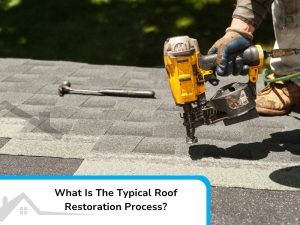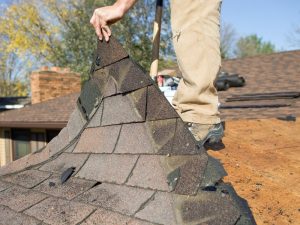For more information on any of the services offered by High Class Roofing or a free no obligation quotation, please complete the following form or call us on 0405 229 765.
What Is The Typical Roof Restoration Process?

Roof restoration is a crucial process that can extend the life of your roof, improve your home’s appearance, and protect it from the elements. If you’re considering a roof restoration, it’s essential to understand the steps involved, why it’s necessary, and what you can expect throughout the process. This article will guide you through the typical roof restoration process, providing valuable insights to help you make informed decisions.
What is the roof restoration process all about?
Roof restoration involves repairing, cleaning, and rejuvenating your roof to bring it back to its original condition or even better. It’s more than just a quick fix; it’s a comprehensive process that addresses various aspects of your roof to ensure it remains durable and practical for years.
- Inspection and assessment: The process begins with thoroughly inspecting your roof to identify any issues such as leaks, cracks, or damaged tiles.
- Cleaning: A high-pressure clean removes dirt, moss, lichen, and other debris that can cause damage or affect the roof’s appearance.
- Repairs: Any damaged areas are repaired or replaced, including cracked tiles, rusted metal, or worn-out sealants.
- Re-coating: The roof is re-coated with a protective layer to enhance its appearance and provide additional protection against the elements, ensuring the integrity of the underlying roof trusses.
- Final inspection: A final check ensures that all work has been completed to a high standard and your roof is ready to face the weather.
Why would you need a roof restoration?
Roof restoration isn’t just for old or damaged roofs; it can benefit almost any roof showing wear and tear. Here’s why you might consider a roof restoration:
- Ageing roof: Roofs naturally degrade over time due to exposure to harsh weather conditions. A roof restoration can give your roof a new lease on life.
- Leaks and water damage: If you notice water stains on your ceiling or walls, it might be time to restore your roof to prevent further damage.
- Improved energy efficiency: A well-maintained roof can improve insulation, helping to regulate your home’s temperature and reduce energy costs.
- Boosting property value: A restored roof can enhance your home’s curb appeal and market value.
- Preventative maintenance: Regular roof restoration can prevent minor issues from becoming significant problems, saving you money in the long run.
What are the steps involved in the roof restoration process?

The roof restoration process is a systematic approach to ensure your roof is in top condition. Each step is crucial to achieving a durable and aesthetically pleasing result.
Steps in the roof restoration process:
- Initial inspection: A professional roofer conducts a detailed inspection to assess the roof’s condition and identify any necessary repairs.
- Roof cleaning: The roof uses high-pressure water to remove dirt, moss, and lichen, ensuring a clean surface for repairs and coatings.
- Repair work: Roofers replace any damaged or broken tiles and repair any necessary structural or metal components.
- Re-bedding and re-pointing: The ridge capping is re-bedded, and re-pointing is done using flexible pointing material to seal the roof’s edges.
- Application of primer: A primer coat is applied to the roof to ensure the topcoat adheres appropriately.
- Top Coat application: A high-quality roof membrane or paint is applied to protect and seal the roof, enhancing its appearance and durability.
- Final inspection: The roofer performs a final inspection to ensure that all work has been completed to a high standard.
How do you prepare your roof for restoration?
Proper preparation is vital to a successful roof restoration. Ensuring your roof is ready for restoration, you can avoid delays and ensure a smooth workflow.
- Clear the area: Remove any obstacles around your home, such as garden furniture or vehicles, to facilitate the roofers’ access.
- Check the weather: Schedule the restoration during dry weather to avoid interruptions caused by rain or storms.
- Inform neighbours: Inform your neighbors about the restoration work, especially if the project involves scaffolding or loud equipment.
- Secure loose items: Secure or temporarily remove any loose items on the roof, such as antennas or solar panels.
- Inspect the roof: Conduct a preliminary inspection to identify any immediate concerns before the restoration begins.
What materials are used in the roof restoration process?
The materials used in the roof restoration process play a vital role in its longevity and effectiveness. High-quality materials protect your roof and keep it looking great for years.
- Roof tiles: Roofers select replacement tiles to match the existing ones, maintaining a consistent look.
- Roof membrane: Roofers apply a protective membrane to seal the roof and prevent water penetration.
- Flexible pointing: Flexible pointing material seals ridge capping, creating a robust bond.
- Roof paint/coating: High-quality roof paint or coating protects against UV rays, weathering, and algae growth.
- Sealants: Roofers apply sealants to waterproof areas around roof penetrations such as chimneys and vents.
How do you maintain your restored roof?
Maintaining your restored roof is essential to ensure it continues to perform well and looks great for years. Regular maintenance can also help you avoid costly repairs in the future.
- Regular inspections: Schedule periodic roof inspections to identify and address any issues before they become significant problems.
- Clean gutters: Keep your gutters clean and free of debris to prevent water buildup and damage to your roof.
- Remove debris: Remove leaves, branches, and other debris from your roof to avoid water retention and moss growth.
- Check for damage: After storms or high winds, check your roof for any signs of damage, such as loose tiles or cracks.
- Professional maintenance: Consider hiring an experienced roofing company to perform regular maintenance and ensure your roof remains in top condition.

Conclusion
A roof restoration process is a comprehensive way to extend the life of your roof, improve your home’s appearance, and enhance its value. While the cost of roof restoration might seem like a significant investment, it often pays off in the long run through increased property value, energy savings, and extended roof lifespan. You can ensure a successful restoration by understanding the typical steps involved, the materials used, and how to prepare and maintain your roof. Regular inspections and maintenance are crucial to preserving the benefits of your restored roof.
Invest in your roof’s future
If you’re considering professional roof restoration, High-Class Roofing provides services tailored to your needs. With a team of experienced roofers and a commitment to quality, we’re here to help you achieve a functional and beautiful roof. Contact High Class Roofing today to learn more about our roof restoration services and how we can help protect your home.

